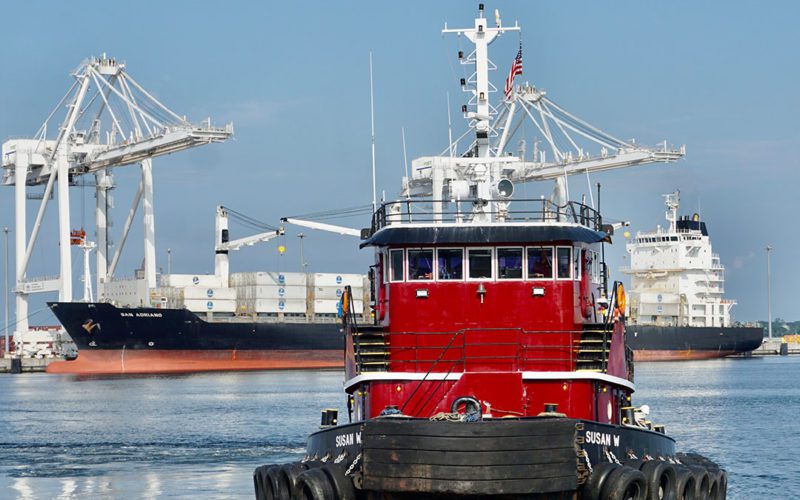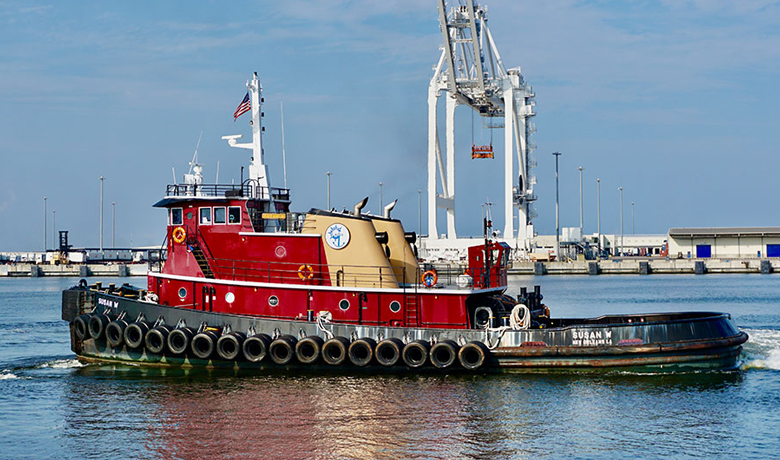

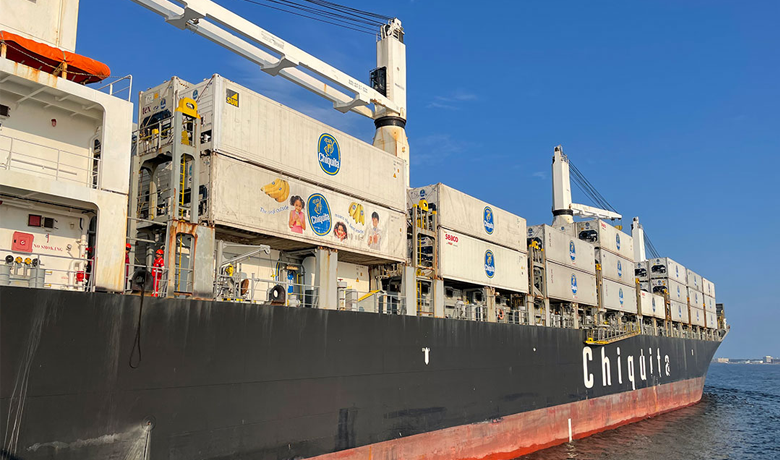
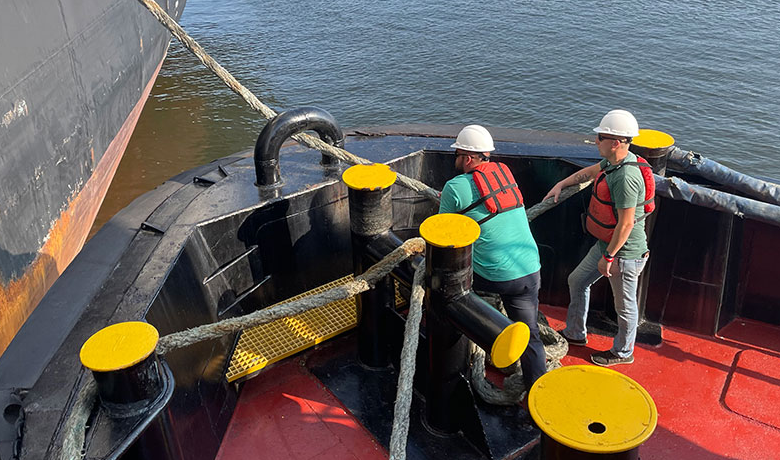
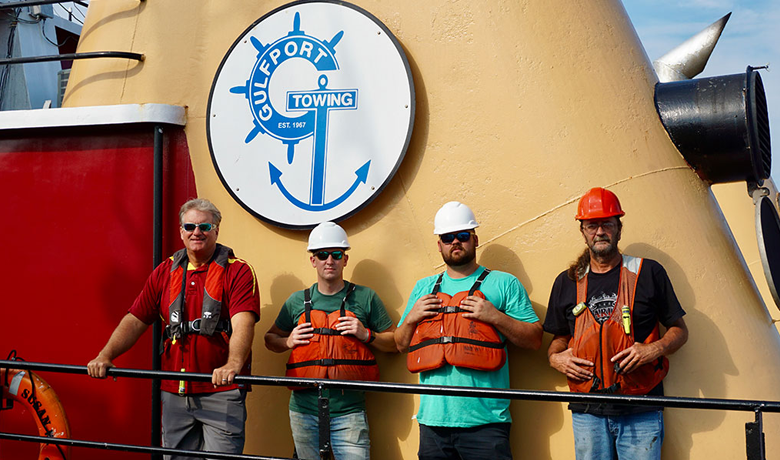
Gulfport Towing Capt. Ken Skrmetta steered Susan W. south toward the Gulf of Mexico’s open waters. Before long, he spotted a familiar sight near the starboard bow.
“Dolphins,” he said, gesturing ahead with his right hand. “They love this boat. We usually get them up front there and they will follow us off the bow. It never gets old to me.”
The 3,200-hp tugboat got underway from Mississippi’s Port of Gulfport minutes earlier on a sunny, hot midsummer morning. Susan W. prepared to meet the inbound containership San Adriano carrying refrigerated Chiquita bananas from Central America.
The docking maneuver for the 608-foot San Adriano is one Skrmetta and his crew know well. It even has a name. “We call it the banana split,” Skrmetta said.
The evolution involves getting a line onto the starboard quarter and then pushing the ship 180 degrees in a turning basin. After hauling in the line, Skrmetta comes around the stern and crews get a line on the port quarter, where Susan W. can push the vessel’s starboard side against the terminal.
Containerized fruit is a major commodity for Mississippi’s busiest port, with Chiquita and Dole ships calling on Gulfport most weeks. Dole’s new class of refrigerated containerships, the 639-foot Dole Aztec and Dole Maya, dock in a similar way.
More than fresh fruit passes through Gulfport’s terminals, which extend more than a mile into the Gulf from golden sandy beaches. The 300-acre port handles more than 200,000 twenty-foot equivalent units (TEUs) and 2 million pounds of cargo annually, according to a port spokeswoman. Some 600 ships call on Gulfport each year, along with occasional barge traffic.
Different bulk products also move through the facility, including ilmenite destined for the Chemours plant in DeLisle, Miss. Other tenants include Crowley Maritime, which uses the site as a container and logistics hub, Harvey Gulf, and the University of Southern Mississippi.
San Adriano approached the terminal under the guidance of Capt. Russ Hilton from the Gulfport Pilots Association. The ship slowed to 7 knots as Susan W. came alongside two miles from the dock.
Skrmetta stayed along the starboard quarter while deck trainee Tyler Schankin got a line onto the ship. Regular deck hand Robert Shavers observed the maneuver from a few feet away. Schankin signaled the line was secure with a thumbs-up to the wheelhouse. Engineer Gary Henzen rounded out the four-person crew.
San Adriano and the other fruit ships normally dock with a single tugboat. Powerful thrusters help guide the bow into position, while a tugboat working the port quarter can work the stern as needed. That dynamic changes in rough weather. Strong winds can push the ships around as they prepare to dock, and seas from the south can add another variable inside the port. In those cases, a second tugboat is used.
“You get a big containership like this one, you get a lot of windage, and so when you get a 30-knot crosswind, you have your hands full trying to keep it off the dock,” Skrmetta said.
There was no wind or rough weather of any kind on this particular morning. After weeks of daily rain and thunderstorms, the skies had finally cleared.
“That makes for a pretty uneventful docking,” Skrmetta said. “Nothing really exciting happens, but I like it like that. We’ve had enough excitement with the spring weather.”
Skrmetta joined Gulfport Towing, a subsidiary of New Orleans-based E.N. Bisso & Son Inc., almost 14 years ago. Prior to that, he operated tour boats on the Mississippi coast — until Hurricane Katrina hit in 2005. The storm devastated the Mississippi coast and with it the region’s tourism economy.
For about a year after the storm, he operated a car ferry between the Mississippi communities of Bay St. Louis and Pass Christian. The route became necessary after the hurricane destroyed the 2-mile Bay St. Louis Bridge connecting the two cities.
“I feel blessed to have come here after Katrina wiped us out with the passenger boats,” the captain said. “I like it. It’s quiet, and it is just three or four guys … compared to 300 people on a tour boat. And even when it’s rough, it’s peaceful.”
Skrmetta runs the Gulfport Towing operation, which has five full-time mariners and two tugboats. The crews work on call 24-7 as needed. The other Gulfport vessel is the 100-foot, 3,600-hp Catherine B., which was built in 1977 and repowered with twin Caterpillar 3516Bs in the early 1990s.
The 110-foot Susan W. is driven by twin Cat 3512s installed in the 1990s with conventional propellers in Kort nozzles. Built in 1982 as General Lee, it was Skrmetta’s choice to replace another conventional tugboat in the Gulfport Towing fleet. Susan W. previously worked on the Lower Mississippi River assisting ships around New Orleans. It came to Gulfport after undergoing extensive repairs and upgrades in nearby Pascagoula.
“They brought the boat to Signet Shipyard and cut the upper wheelhouse off, rebuilt the bulwarks and did all kinds of work,” he recalled. “Now, I have it where I like it. She’s a good little tug.”
Hilton, the Gulfport pilot, gave the word over the radio that he planned to begin backing San Adriano. The ship moved sternward at about 2 knots, slowing as it eased into position at West Pier No. 1. Susan W. initially remained alongside to assist as needed with its taut 2.25-inch Samson AmSteel-Blue line.
Unlike modern z-drive tugboats, which provide 360-degree thrust on demand, conventional tugs must remain parallel to a moving ship. They can exert thrust to port or starboard on the pilot’s command by twin-screwing the engines into or away from the hull.
“He’s got us all-stop right now, so I am twin-screwing on a tight line and just holding position where I can back or shove, whatever he needs, really quick,” Skrmetta explained. “I have a good position on him.”
“These headlines are designed if you ease into them slow and back hard, you can’t part them,” he added.
Apparently satisfied with the tugboat’s position, Hilton asked over the radio for Susan W. to position itself with its bow pushing against the ship’s port quarter.
“Go ahead and nose in on me and stand by to push,” Hilton said.
“We are on the 45 and coming around to 90,” Skrmetta responded.
Hilton ordered dead slow ahead, which Skrmetta again confirmed.
“Coming astern on my engines again,” Hilton said a moment later. “Roger that,” Skrmetta answered.
Thus went the docking evolution over the next 10 or so minutes. Longshoremen called out distances as San Adriano inched into position.
Once complete, Skrmetta and Hilton traded a few good-natured jokes over the private radio channel. Then Susan W. began the short trip across the harbor to the East Pier, where it tied up against Catherine B.
The crew had some downtime ahead before being called upon to assist the ship off the dock. That maneuver, Skrmetta said, is a simpler affair.
“It takes about 10 minutes. We pull him off the dock and off he goes.”

